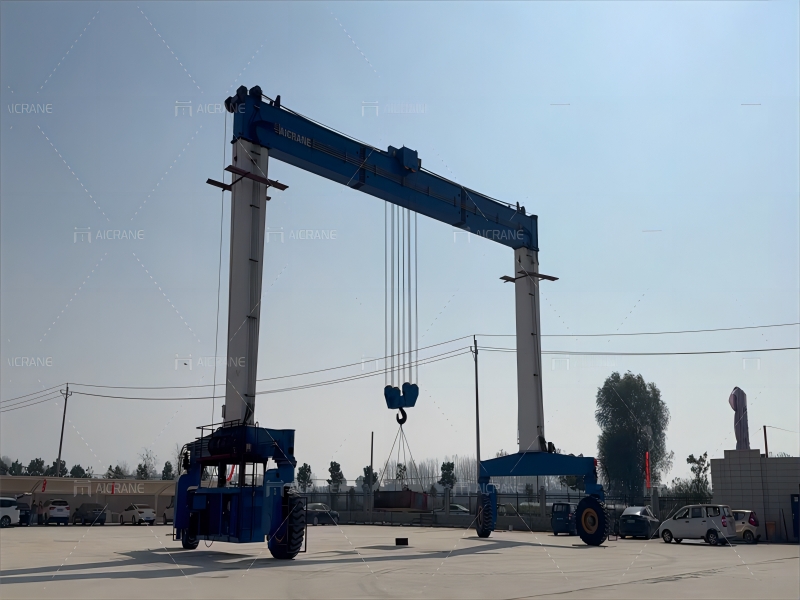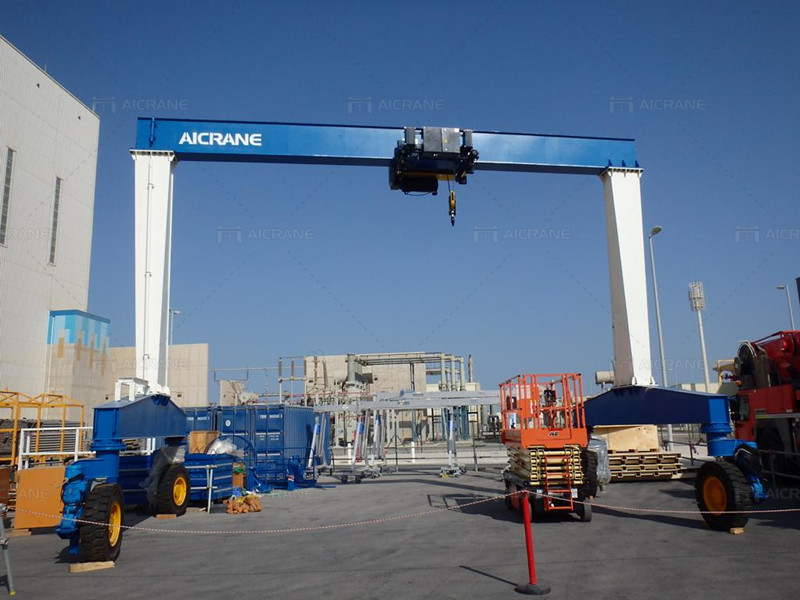Installing a rubber tire gantry crane is a complex and critical process that requires careful planning, precision, and adherence to safety protocols. Rubber tire gantry cranes are mobile lifting solutions commonly used in container yards and intermodal facilities for efficient container handling. In this comprehensive guide, we will explore the step-by-step process of installing a rubber tire gantry crane, covering key considerations, safety measures, and essential tasks.

Site Preparation
Before initiating the installation process, thorough site preparation is essential. This includes:
Foundation Inspection: Verify that the ground is stable and capable of supporting the crane’s weight and dynamic loads. Conduct soil tests to ensure proper foundation design.
Clear the Area: Remove any obstacles, debris, or structures from the installation site to create a clear and unobstructed space for the crane.
Leveling: Ensure the installation area is level to prevent issues with crane stability and alignment during operation.
Foundation Construction
The construction of a solid foundation is crucial for the stability and performance of the rubber tire gantry crane:
Concrete Foundation: Construct a reinforced concrete foundation with proper dimensions and strength to support the crane’s load.
Anchor Bolts Installation: Embed anchor bolts into the foundation to secure the crane’s legs. The bolts should be positioned according to the crane manufacturer’s specifications.
Alignment: Ensure precise alignment of the anchor bolts to facilitate the accurate placement of the crane on the foundation.
Crane Assembly
Once the foundation is in place, the crane assembly process begins:
Unloading and Unpacking: If the crane components are delivered in parts, unload and unpack them carefully, ensuring that all components are accounted for and undamaged.
Assembly of Structural Components: Begin assembling the structural components of the crane, including the main frame, legs, and boom. Follow the detailed assembly instructions provided by the manufacturer.
Installation of Wheels and Drive System: Attach the rubber tires and install the drive system, ensuring proper alignment and secure attachment to the crane structure.
Connection of Electrical Components: Connect the electrical components, including the control panel, motors, and sensors, following the manufacturer’s wiring diagrams.
Erection of the Crane
The next step involves the actual erection of the rubber tire gantry crane:
Lifting and Positioning: Use appropriate lifting equipment, such as mobile cranes, to lift the assembled crane components and position them over the foundation.
Lowering onto Foundation: Lower the crane onto the foundation, ensuring that the anchor bolts align with the designated holes in the crane legs.
Bolt Fastening: Securely fasten the crane to the foundation by tightening the anchor bolts according to the manufacturer’s torque specifications.
Alignment Checks: Verify the alignment of the crane legs and structure, making any necessary adjustments to ensure proper positioning.

Testing and Commissioning
Testing and commissioning are critical phases to confirm the crane’s functionality and safety:
Functional Tests: Conduct comprehensive functional tests on all crane components, including the lifting mechanism, trolley movement, and any specialized features.
Load Testing: Perform load testing to ensure that the crane can handle the specified loads without issues. Gradually increase the load to assess the crane’s stability and performance.
Safety System Checks: Verify the proper functioning of safety systems, such as limit switches, emergency stops, and overload protection mechanisms.
Operational Tests: Conduct operational tests to simulate real-world conditions and confirm that the crane operates smoothly and efficiently.
Training and Documentation
Training operators and documenting installation details are essential for safe and effective crane operation:
Operator Training: Provide comprehensive training for crane operators, covering operational procedures, safety protocols, and emergency response measures.
Documentation: Maintain detailed documentation of the installation process, including foundation specifications, assembly procedures, test results, and any adjustments made during commissioning.
Regulatory Compliance
Ensure compliance with local regulations, standards, and safety guidelines throughout the installation process:
Permits and Approvals: Obtain any necessary permits and approvals from relevant authorities before and during the installation.
Inspections: Schedule inspections by regulatory authorities to verify compliance with safety standards and regulations.
Certifications: Ensure that the rubber tire gantry crane meets all applicable certifications and standards for safe operation.
Post-Installation Checks
After installation and commissioning, conduct thorough checks to confirm the crane’s readiness for regular operation:
Final Alignment Checks: Perform final alignment checks to confirm that the heavy duty crane is positioned correctly on the foundation.
Visual Inspection: Conduct a visual inspection of all components to identify any signs of wear, damage, or potential issues.
Calibration: If applicable, calibrate instrumentation and control systems to ensure accurate readings and performance.
Operational Handover
Once all checks are completed successfully, the operational handover can take place:
Client Acceptance: Obtain acceptance from the client or end-user after demonstrating the crane’s operational readiness and compliance with specifications.
Handover Documentation: Provide the client with comprehensive documentation, including operation and maintenance manuals, as-built drawings, and any relevant certificates.
Post-Installation Support
Offer post-installation support to address any questions, issues, or maintenance needs:
Training Follow-Up: Follow up with additional training or support for crane operators as needed.
Scheduled Maintenance Plans: Establish a scheduled maintenance plan to ensure the ongoing reliability and safety of the rubber tire gantry crane.
Emergency Support: Provide contact information for emergency support and address any unexpected issues promptly.
Installing a rubber tire gantry crane requires meticulous planning, precise execution, and a strong focus on safety. By following these steps and adhering to manufacturer guidelines and industry standards, the installation process can be carried out efficiently and effectively. Regular maintenance, training, and compliance with safety regulations contribute to the long-term success of the rubber tire gantry crane in its role of handling containers and supporting logistical operations.